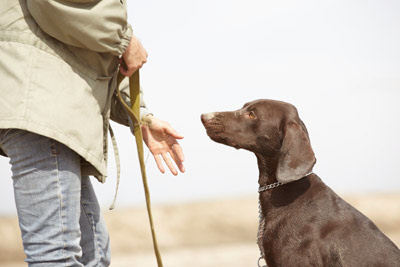Gun Dog Basics: Stay Command

How to Train your Dog to Stay
Teaching your gun dog the “stay command” is essential for his safety and effectiveness when out in the field. If a dog cannot stay in one place when asked, she/he cannot be trusted on the hunt. As a dog owner, you must be sure your animal will obey this command, so follow the below steps to train your dog to stay:
Before You Train a Hunting Dog
As with all training, patience is paramount. Getting frustrated with your animal will not get you anywhere. For the animal’s point of view, imagine someone trying to teach you a completely foreign skill, while you are distracted, in a language you can’t understand. You’ll need to temper your patience throughout the process. Remember: Training a dog is easiest when she is relaxed and well-exercised.
NOTE: The following steps assume your animal can already perform on a sit command. If Rover can’t sit quite yet, begin training with the sit command instructional. There are a number of ways to train your hunting dog, and it is best to use whatever is the most effective for her.
Teaching the “Stay” Command
- Get him to sit or lay down. This will be the starting position your dog will return to for each repetition during the training. Be prepared, there will be a lot of them. Both starting positions have advantages and disadvantages.
- Sitting - The advantage to sitting comes in the environment; if it is wet or snowy, as it often is in a hunt, your dog will be more comfortable and less vulnerable in a sitting position. Sitting’s disadvantage is how much harder sitting is for a dog to maintain over several minutes.
- Laying – Hunting dogs with dense fur may enjoy laying down for their starting position, and will likely be able to hold it longer, while remaining free from distraction. Keeping lower to the ground has obvious camouflage benefits as well.
- Have a release command ready. This can be just about any word, but be aware of what the word may sound like and how often you use it in everyday speech. For instance, “Okay” is used quite often in everyday speech, and “Go” sounds an awful lot like “No” to a dog. You’ll want to keep the “No” command separate, for obvious reasons.
- Hold off on the sit/lay reward. When your dog obeys the sit/lay command, wait a moment before rewarding her with a treat. If she stays, deliver her treat low and between her front legs if she’s lying, and around her chest if sitting. Positioning a treat higher will tempt the dog to break position.
- Give release command. Immediately after the treat has been given, tell him the release command and make sure he gets up. This won’t likely be hard.
- Repeat step 3. Do about 10 repetitions of step three, and start gradually increasing the length of time between sit/lay and reward.
- Introduce distance. Once she is able to hold it for more than about four seconds, take a step back with your next repetitions. Be sure you’re facing the dog as you step back to keep her locked into the training. Reward the animal if she stays as the distance increases, even if you see a drop in the time she is able to hold. As you increase a variable, such as distance, allow for leniency on other variables, like duration or distractions.
- Introduce distraction. When your hunting dog can hold for over a minute as you stand ten feet away, begin presenting distractions. Throw a ball or move around a little bit. Turn your back and point in other directions. Make a treat visible to him. Be creative. Or you could try one of Northland Dog Supply’s dead fowl trainers.
- Eventually try walking behind your dog. This hits on a few variables at once and is especially difficult for them. Moving out of her sight will be a particular challenge, so take it slow.
- Add the “Stay” command. Because there are so many variables (distance, duration, and distraction) and phases to this training, you should only begin associating the command with the act once the act is fully ingrained. Vocalizing the command before it is fully taught will confuse the dog into associating the word with incomplete actions.
Eventually, your hunting dog should be able to stay indefinitely, which will prove an invaluable skill to be built upon on your animal’s way to becoming an expert hunting companion.
Northland is your Hunting Dog Supplier
From training implements to hunting equipment, Northland Dog Supply has all you need for your fowling dog to be prepared for the next big hunt. We are a premier supplier of the latest hunting vests, firearm supplies and TruckVault storage solutions.

